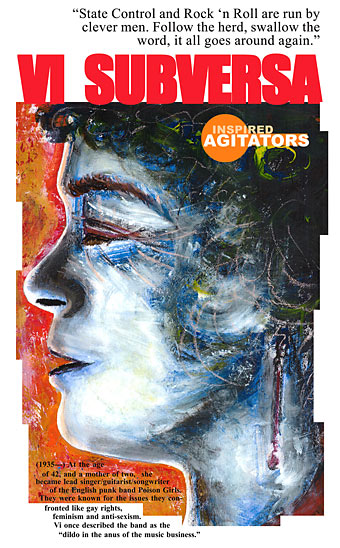 Every Saturday, we’ll be posting a new illustration by David Lester. The Mecca Normal guitarist is visually documenting people, places and events from his band’s 25-year run, with text by vocalist Jean Smith.
Every Saturday, we’ll be posting a new illustration by David Lester. The Mecca Normal guitarist is visually documenting people, places and events from his band’s 25-year run, with text by vocalist Jean Smith.
Looking around on YouTube, finding Crass interviews, songs with static images made by fans, live clips and documentary footage, I saw a comment—”it’s so? fuckin awesome how Crass’ message can be related today!” In a way, yes, totally awesome, dude, but in another way: It still is today. Technology and culture spin along at remarkable speeds, churning up new products to consume, dumping last week’s model for the latest marvel—profit-driven intensity regulated by consumer propensity. Other facets of life don’t change as quickly: pollution, poverty, feminism, racism, out-dated political constructs and corruption. There’s an interview with Crass drummer Penny Rimbaud where he’s saying he was amazed that people—the audience—found their way to a tin hut in a field in Wales for an enjoyable evening that included conversation about ideas and inspiration. He said if they’d been offered a pile of money to go and ponce around on a stage with lights, they wouldn’t have taken it. “It wasn’t what we were doing.” I’m happy their influence is being felt today. I’m inspired by Crass—now, today. Their ideas are worth considering and bringing into new projects. Crass colleagues Poison Girls were fronted by Vi Subversa—she was a middle-aged mother of two when she started a punk band to sing about sexism and gay rights. Mecca Normal’s first show in England was on a bill with Vi at Apples & Snakes in London in 1989. We ended up with a show with Poison Girls six months later at an East London hall, and we stayed with them—Poison Girls—for a day or two before the show, during which time Vi was having a birthday party. I thought it was her 60th, but Dave figures it was more like 55; either way, she seemed old to us, and we weren’t even all that young—about 30. They lived in a fairly big house with a garden, and evidently, when they needed cash, they sold slices off the back end of the property to their neighbor. This was somewhere near Dial House: the Crass house. Poison Girls had a history with Crass—working together, doing shows, a benefit single—10 years prior. To us, visiting in 1989, that all seemed a long time ago. Time creates distance differently as I get older. As a kid in the ’60s, World War II seemed like the distant past. Now, 40 years later, World War II seems remarkably recent. Anyway, we were sort of hanging out, trying not to use all the hot water or finish the last bit of milk, you know, basically just stay out of their hair. We didn’t have a car and they weren’t really near anything and we didn’t really know them; we were just there, waiting to do the show. It was a bit awkward being at Vi’s party—people arriving, flowers, booze, food. I think Vi and Richard Famous lived at the house with a little white dog named Mister. Their drummer, Lance d’Boyle, turned up, as well as one of her kids, I think. It was extremely exciting—thrilling—to be playing with Poison Girls. My god!!! Poison Girls!!! Christ. I’m sure we were nervous, wondering if they’d say anything to us. And, indeed, Richard came over after, and we waited for him to say what he thought, wondering what Richard Famous, guitar player of Poison Girls, thought of Mecca Normal—about our songs, our sound. He suggested we get matching outfits.






